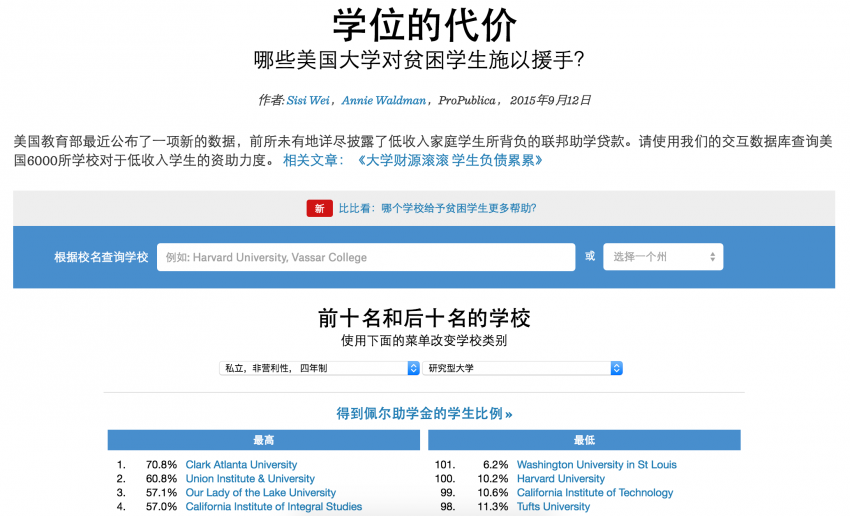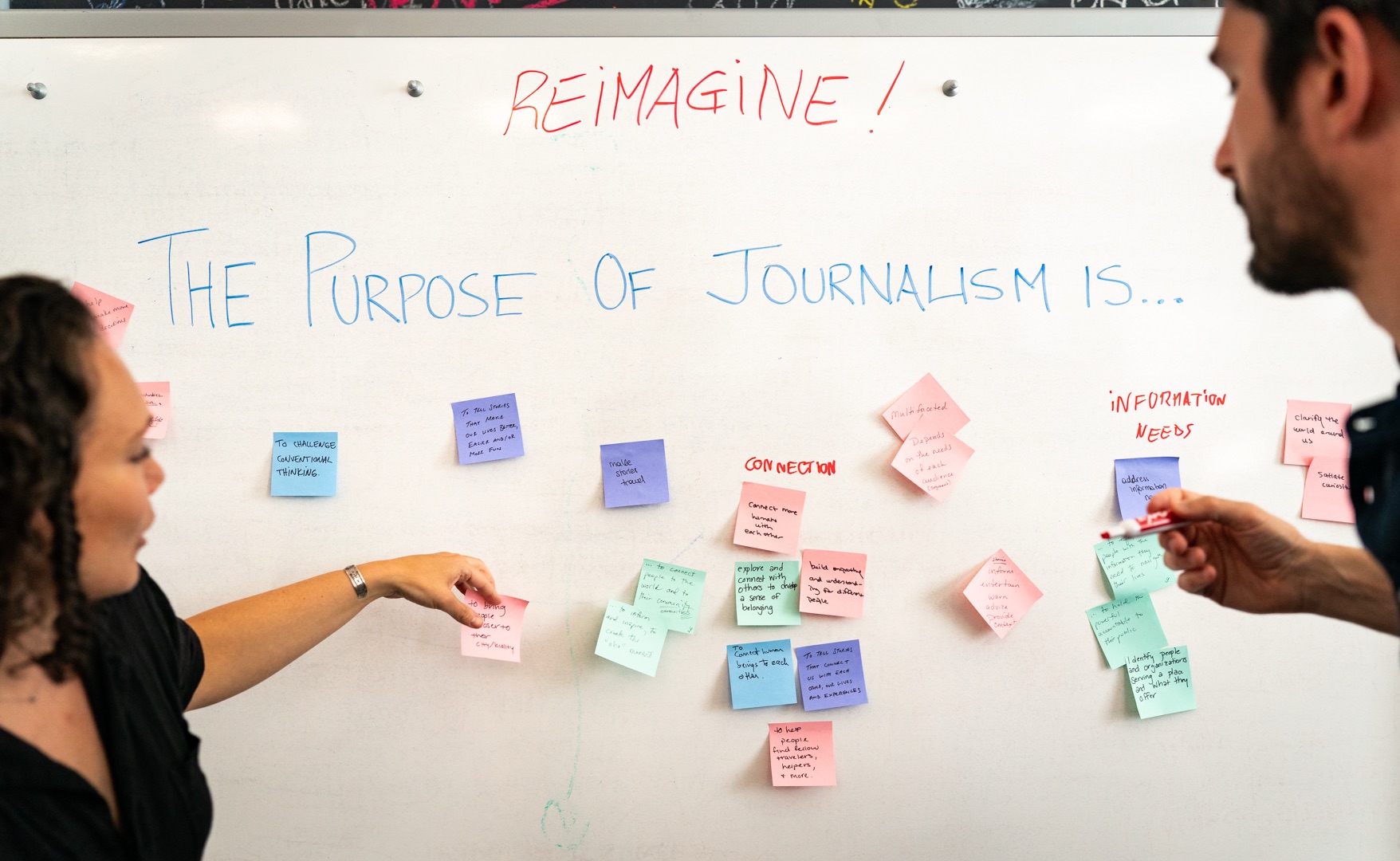This story is part of a series on bringing the journalism we produce to as many people as possible, regardless of language, access to technology, or physical capability. Find the series introduction, as well as a list of published stories here.
More than 60 million people in the United States speak a language other than English at home. Of those, 25 million report that they “speak English less than very well,” according to Census Bureau report. That sizable population, along with all the non-English speakers around the world, is one reason newsrooms are making an extra effort lately to translate articles, especially when the topic affects a particular community.
Think, for example, of NPR’s translation of a Look At This visual story about the Brazilian rain forest to Spanish and Portuguese, or The New York Times' launch of NYT en español, or BuzzFeed’s translation of an interview with President Obama to Spanish, French, Portuguese and German.

These recent efforts to reach new audiences both in the U.S. and abroad raise all sorts of questions for newsrooms about strategy and workflow. Translation is tricky when you're dealing with text alone, but becomes even more complicated when interactive news applications and graphics come into play.
What should be translated?
Whether a story is a good candidate for translation or not frequently comes down to how likely the story is to resonate with an intended audience, particularly if the story features a Spanish-speaking person, said Fernando Diaz, a senior editor at The Center for Investigative Reporting and Reveal.
“If it’s a story that could really benefit a Spanish-speaking audience, then we build out the workflow,” Diaz said. Every translation starts with hiring a translator to create a word-for-word translation from an English reference text. The goal is to stay “as accurate and faithful to the intent of the English-language piece (as possible),” he said.
Apart from featuring Spanish-speakers, partnership with certain news organizations are also increase the likelihood that a story will be translated. Recently CIR partnered with Frontline and Univision to complete Rape in the Fields, a project about assaults that many migrant women suffer while working in America’s fields and plants. The story was obviously pertinent to Spanish-speaking audiences given the subject matter, but the Univision partnership made translation necessary and also made reaching a new audience less difficult, Diaz said.
Though CIR and others translate a fair number of stories each year, a market of news-hungry, foreign-born citizens seeks ever more news. Some argue that original reporting in various languages is needed to fill the void, while others are happy to continue and improve translations, Diaz said.'While many people will argue until they’re blue in the face that translating is not enough, the absence of news is not better.'
“The reality is that so much of our content is translated that it’s impossible to distinguish what language it started in,” he said. “While many people will argue until they’re blue in the face that translating is not enough, the absence of news is not better. There is a case to be made that the stories won’t resonate or people won’t relate. But if the story is important and civic, then who cares if this story was translated. The fact is that if it weren’t translated, it wouldn’t exist.”
Road bumps to translation
One of her biggest challenges in translating stories is finding the appropriate dialect and age-appropriate language for your audience, said Mayra Báez Jimeno, a reporter and video producer for AJ+ Español in Bogota, Colombia.
“In Spanish, you have young people talking very differently in each country,” Jimeno said. “And within each country, young people talk differently in each region. Finding a common, cool millennial language is very hard.”
It helps to have a diverse set of eyes to help research and edit each piece, she said. It’s important to her team to try and preserve the meaning of an original quote as much as they can, no matter what language it originated in. So they have at least two or three people who speak the language looking at the content. The team will often debate when they don’t agree on certain translated words or phrases in order to find the best common option. They even try to reach friends in the country, particularly in Latin America, that they are reporting on. “I think having native people helping is the best way when we can’t do it by ourselves,” Jimeno said.
Finding the right people is key at CIR, as well, Diaz said. Ideally CIR would be able to recruit people to work effectively in various languages, but adding deep language skills to a team is a particular challenge at an investigative organization. Being able to extract important information from court documents, sift through thousands of lines of data and understanding FOIA requests are skills that often trump fluency in a second language when it comes to recruiting.
Translating news apps
News apps and interactives offer a fresh set of challenges when it comes to translation, said Sisi Wei, a journalist and developer at ProPublica.
Wei worked on worked on Debt by Degrees, a news app that looked at the financial support that US offer to poor families, and was presented in three languages.
“We were specifically making an app about school performance regarding low-income students,” Wei said. “We wanted to target Spanish and Chinese speakers in the United States, or maybe elsewhere who were considering sending their kids to schools in the US.”

The ProPublica team worked in English and then sent the copy to translators. The translators (Cecilia Reyes for Spanish and Yue Qiu for Chinese) gave it a first pass, edited themselves, looked at the translated copy in the application, edited some more, had it edited by a second person, and so on.
Translating news apps is interesting because there are a lot of small visual elements that contribute to the user’s interaction and experience, Wei said. Labels like “high” and “low” had to be rethought. In certain cases, punctuation had to change. Even numbers had to change in certain ways.
“We’d say something like ‘12K’ to mean 12,000 or ‘13B’ to mean 13 billion,” Wei said. "In Chinese, there are no such things as billions or millions. They have units we don’t have, so it just shifts everything. If you switch to the Chinese version and you couldn’t read it, you would think we changed it on you and made it 10 times bigger or something. But in fact it’s because of the way that translations of the numbers work in Chinese. We have to think of every possible permutation of everything we had coded.”
For everything to make sense in different languages, they often had to write exceptions in their code to accommodate different grammar and paragraph structure, along with how much space these differences would take up on the page. Every little detail mattered in the text because to a native Chinese or Spanish reader, mistakes were very obvious, Wei said.
These challenges often slowed down the process of not only launching the application, but also keeping it updated. “Essentially every new word you write has to go through five other people,” she said. “It has to go through my editor, then the translator, then through both editors and translators. And people can’t just drop what they’re doing and translate immediately.”
Luckily, translation becomes easier with each project, she said. When ProPublica translated its first project in 2013 (a story about Weibo, China’s Twitter equivalent) they used I18N, a Ruby gem that provides multi-language support for Ruby on Rails applications. (Fun fact: I18N takes its name from the 18 letters between I and N in “internationalization.")
For the more recent college project, the team hacked together an integration between The New York Times’ ArchieML tool I18N so that the writers and editors could essentially make changes in a Google Document template that Wei had previously set up which would update with the application automatically.
“I’ve learned that it takes some time, but it’s not that hard to do,” Wei said. “Once you do it, it’s actually quite easy for translation to iterate and change without you needing to code more, so that’s really cool.”
Increased audience interaction
Translated stories and apps frequently lead to increased audience interaction, both for jobs well done and jobs that could have been better.
“People are constantly checking on us .... When we make some mistake, or we do not translate well ... we have a good interaction with the audience,” Jimeno said. She and her team reply in Facebook comments to people who point out errors to let them acknowledge their mistakes. For the team, it’s a red flag that signals a need for a better workflow: what went wrong, who should've been consulted, what can be done better the next time?
Wei said that when ProPublica released Debt by Degrees separately in Spanish and Chinese, they saw Twitter conversations about the project in multiple languages. “There was one person who specifically said, ‘I read this all in English, and then I read it again in Chinese,’” she said.'When the stories have a universal flavor, the meaning is not lost.'
In the end, translation seems to work best in reaching and resonating with audiences when the stories are universal, Jimeno said. The best candidates for translation "appeal to global values and struggles that … people have all around the world," she said. “When the stories have a universal flavor, the meaning is not lost.”
Some more reading on this topic:
Other translated pieces:
- The Price of Nice Nails - The New York Times
- Por qué es casi imposible encontrar una tortilla de maíz decente en Estados Unidos // I tried to make my own tortillas from scratch the Mexican way in the US, and it was a disaster - Quartz
- Rape on the Night Shift - Frontline, Univision, Reveal, IRP, KQED Reteam
Alex Duner contributed to this story.
About the author





